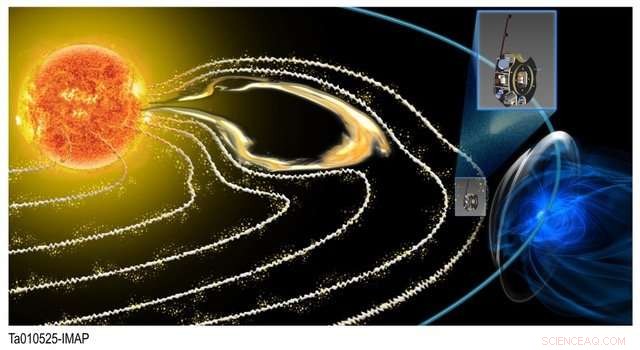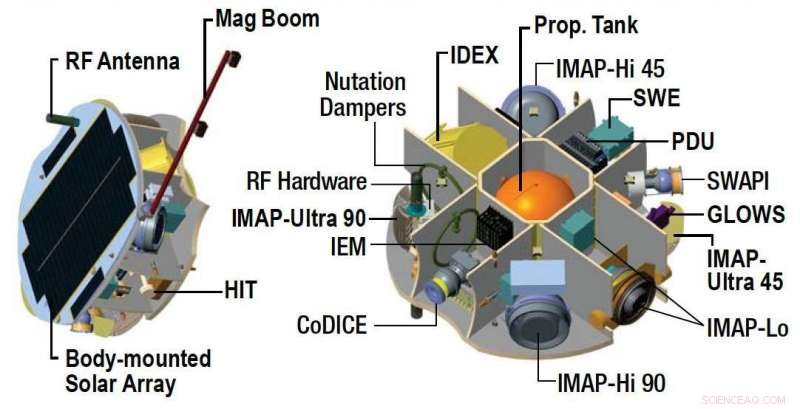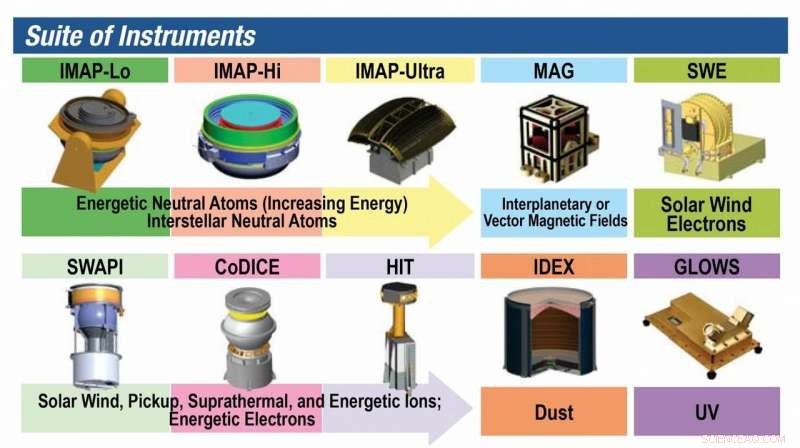Princetons McComas vai liderar o IMAP, uma missão da NASA para estudar a heliosfera
 p O astrofísico de Princeton David McComas será o investigador principal da Sonda de Mapeamento e Aceleração Interestelar (IMAP), uma missão lançada em 2024 para investigar a heliosfera, a região onde as partículas que fluem do sol esculpem uma bolha no meio interestelar. IMAP orbitará o sol em L1, a um milhão de milhas ao sol da Terra, onde estará fora do envelope protetor do campo magnético da Terra (mostrado aqui em azul). Crédito:equipe IMAP
p O astrofísico de Princeton David McComas será o investigador principal da Sonda de Mapeamento e Aceleração Interestelar (IMAP), uma missão lançada em 2024 para investigar a heliosfera, a região onde as partículas que fluem do sol esculpem uma bolha no meio interestelar. IMAP orbitará o sol em L1, a um milhão de milhas ao sol da Terra, onde estará fora do envelope protetor do campo magnético da Terra (mostrado aqui em azul). Crédito:equipe IMAP
p O astrofísico de Princeton David McComas será o principal investigador de uma missão científica para amostrar, analisar e mapear partículas que fluem do sol e das bordas do espaço interestelar para a Terra. Ele está apresentando os objetivos e o status da missão no Comitê Internacional de Pesquisas Espaciais (COSPAR) reunido hoje em Pasadena, Califórnia. p Programado para lançamento em 2024, a missão de mapeamento interestelar e sondagem de aceleração (IMAP) investigará a heliosfera, que envolve e protege nosso sistema solar, Funcionários da NASA anunciaram em 1º de junho.
p Na região limite da heliosfera em forma de bolha, o vento solar - o fluxo constante de partículas empurrando em todas as direções do nosso sol - colide com as partículas do meio interestelar, o espaço não totalmente vazio entre as estrelas. A maioria das radiações cósmicas nocivas é protegida nesta fronteira; IMAP irá coletar e analisar as partículas que passam, bem como outros que são gerados nesta região crítica.
p "O IMAP investiga simultaneamente duas das questões mais importantes da heliofísica hoje - a aceleração das partículas energéticas e a interação do vento solar com o meio interestelar, "disse McComas, um professor de ciências astrofísicas e vice-presidente do Laboratório de Física de Plasma de Princeton.
p A missão de US $ 492 milhões incluirá um conjunto de 10 instrumentos que trabalharão juntos para resolver questões científicas sobre o vento solar e o meio interestelar, do básico - o que exatamente está lá fora? - ao complexo:como as partículas solares interagem com as partículas interestelares, e como essa interação evolui no tempo e no espaço?
p O IMAP também coletará dados sobre como os raios cósmicos são filtrados pela heliosfera. Essas partículas representam riscos para astronautas e sistemas tecnológicos, e pode desempenhar um papel na presença da própria vida no universo.
p Grande parte da proteção da Terra contra a radiação cósmica acontece por causa da heliosfera, disse Dennis Andrucyk, vice-administrador associado da Diretoria de Missão Científica da NASA em Washington, D.C. "O IMAP é fundamental para ampliar nossa compreensão de como esse 'filtro cósmico' funciona. As implicações dessa pesquisa podem ir muito além da consideração dos impactos terrestres, pois buscamos enviar humanos para o espaço profundo."
p O IMAP orbitará um ponto a cerca de um milhão de milhas em direção ao Sol da Terra no primeiro ponto LaGrange (L1), uma localização astronômica onde a atração gravitacional do Sol é equilibrada com a da Terra. O IMAP ficará entre o sol e a Terra, permitindo que alguns instrumentos examinem as partículas do vento solar in-situ, enquanto outros mapeiam os pontos mais distantes do sistema solar.
p A missão é projetada para atingir seus objetivos básicos nos primeiros dois anos, mas tem energia e consumíveis suficientes para sobreviver pelo menos cinco anos em L1, para permitir retornos ainda maiores da ciência.
 p O astrofísico de Princeton David McComas será o investigador principal do IMAP, uma missão científica de $ 492 milhões para provar, analisar e mapear partículas do sol e das bordas do espaço interestelar. Programado para lançamento em 2024, a missão de Mapeamento Interestelar e Sonda de Aceleração investigará a heliosfera, que envolve e protege nosso sistema solar. O IMAP é um satélite giratório do tamanho e forma de um carrossel infantil, 6,5 pés de diâmetro e 2 pés de altura (aproximadamente 200 cm x 70 cm). Todos os instrumentos científicos funcionarão continuamente enquanto gira no espaço quatro vezes por minuto. Os 10 instrumentos no IMAP são de "alto patrimônio, comprovadas "ferramentas de voo, o que significa que eles são muito semelhantes aos instrumentos usados com sucesso em uma ou mais missões anteriores. Três dos instrumentos - IMAP-Lo, IMAP-Hi e IMAP-Ultra - usarão átomos energéticos neutros para "ver" partículas da heliosfera invisível e além. Os sensores serão calibrados nas mesmas instalações que instrumentos semelhantes de missões anteriores, permitindo IMAP construir a partir do conjunto de dados que vem se acumulando desde 2008. Os três instrumentos IMAP têm maior resolução e muitas vezes o poder de coleta das missões anteriores (em média, 15 vezes, 25 vezes e 35 vezes, respectivamente, para os três instrumentos). Cinco instrumentos - CoDICE, BATER, MAG, SWAPI e SWE - irão medir diferentes componentes do vento solar e partículas energéticas que irão permitir a compreensão detalhada da aceleração de partículas, além de fornecer dados em tempo real sobre o clima espacial em direção à Terra. Os outros dois instrumentos, IDEX e GLOWS, examinará a poeira interestelar e a radiação ultravioleta. Crédito:equipe IMAP
p O astrofísico de Princeton David McComas será o investigador principal do IMAP, uma missão científica de $ 492 milhões para provar, analisar e mapear partículas do sol e das bordas do espaço interestelar. Programado para lançamento em 2024, a missão de Mapeamento Interestelar e Sonda de Aceleração investigará a heliosfera, que envolve e protege nosso sistema solar. O IMAP é um satélite giratório do tamanho e forma de um carrossel infantil, 6,5 pés de diâmetro e 2 pés de altura (aproximadamente 200 cm x 70 cm). Todos os instrumentos científicos funcionarão continuamente enquanto gira no espaço quatro vezes por minuto. Os 10 instrumentos no IMAP são de "alto patrimônio, comprovadas "ferramentas de voo, o que significa que eles são muito semelhantes aos instrumentos usados com sucesso em uma ou mais missões anteriores. Três dos instrumentos - IMAP-Lo, IMAP-Hi e IMAP-Ultra - usarão átomos energéticos neutros para "ver" partículas da heliosfera invisível e além. Os sensores serão calibrados nas mesmas instalações que instrumentos semelhantes de missões anteriores, permitindo IMAP construir a partir do conjunto de dados que vem se acumulando desde 2008. Os três instrumentos IMAP têm maior resolução e muitas vezes o poder de coleta das missões anteriores (em média, 15 vezes, 25 vezes e 35 vezes, respectivamente, para os três instrumentos). Cinco instrumentos - CoDICE, BATER, MAG, SWAPI e SWE - irão medir diferentes componentes do vento solar e partículas energéticas que irão permitir a compreensão detalhada da aceleração de partículas, além de fornecer dados em tempo real sobre o clima espacial em direção à Terra. Os outros dois instrumentos, IDEX e GLOWS, examinará a poeira interestelar e a radiação ultravioleta. Crédito:equipe IMAP
p
Conheça o IMAP
p IMAP é um satélite giratório do tamanho e formato de um carrossel infantil, 6,5 pés de diâmetro e 2 pés de altura (aproximadamente 200 cm x 70 cm). Todos os instrumentos científicos funcionarão continuamente enquanto gira no espaço quatro vezes por minuto. Os 10 instrumentos no IMAP são de "alto patrimônio, comprovadas "ferramentas de voo, o que significa que eles são muito semelhantes aos instrumentos usados com sucesso em uma ou mais missões anteriores.
p Três dos instrumentos - IMAP-Lo, IMAP-Hi e IMAP-Ultra - usarão átomos energéticos neutros para "ver" partículas da heliosfera invisível e além. Os sensores serão calibrados nas mesmas instalações que instrumentos semelhantes de missões anteriores, permitindo IMAP construir a partir do conjunto de dados que vem se acumulando desde 2008. Os três instrumentos IMAP têm maior resolução e muitas vezes o poder de coleta das missões anteriores (em média, 15 vezes, 25 vezes e 35 vezes, respectivamente, para os três instrumentos).
p Cinco instrumentos - CoDICE, BATER, MAG, SWAPI e SWE - irão medir diferentes componentes do vento solar e partículas energéticas que permitirão a compreensão detalhada da aceleração de partículas, além de fornecer dados em tempo real sobre o clima espacial em direção à Terra.
p Os outros dois instrumentos, IDEX e GLOWS, examinará a poeira interestelar e a radiação ultravioleta.
p Como investigador principal de toda a missão IMAP, McComas is leading the team that includes scientists from 24 institutions in the United States, Alemanha, Polônia, Switzerland and Japan. He is also the lead investigator for the SWAPI instrument.
p "The IMAP science team consists of many of the world's leaders in instrumentation, data analysis, theory and modeling, and understanding of the global heliosphere, " McComas said. Together, IMAP's 10 instruments will provide "the first comprehensive in-situ and remote global observations to discover the fundamental physical processes that control our solar system's evolving space environment."
p
Focus on the IMAP instruments
p IMAP-Lo, a single-pixel neutral atom imager mounted on a pivot platform, will measure low-energy (5-1000 eV) interstellar neutral atoms of hydrogen, hélio, oxigênio, neon and deuterium.
 p The 10 instruments aboard the Interstellar Mapping and Acceleration Probe will investigate the heliosphere under the leadership of Princeton astrophysicist David McComas:IMAP-Lo, a single-pixel neutral atom imager mounted on a pivot platform, will measure low-energy (5-1000 eV) interstellar neutral atoms of hydrogen, hélio, oxigênio, neon and deuterium.IMAP-Hi has two single-pixel imagers that will measure mid-energy neutral atoms (0.4-15.6 keV) at 4° angular resolution.IMAP-Ultra's two identical imagers will use slit optics to cover three-quarters of the full celestial sphere with each spin. It will measure high-energy (3-300 keV) neutral atoms with 2° resolution.The Compact Dual Ion Composition Experiment (CoDICE) will measure the composition and movement of two broad energy ranges of ions simultaneously, to advance our understanding of particle acceleration in the heliosphere.The High-energy Ion Telescope (HIT) is a spectrometer that will inventory the charge, energia, orientation and mass of ions from hydrogen to nickel, to determine whether they originate in the solar wind or the interstellar medium.MAG, a pair of identical magnetometers, will measure the local interplanetary magnetic field and provide new insights into the waves and turbulence of the solar wind's plasma.The Solar Wind Electron (SWE) instrument will measure the 3-dimensional distribution of thermal and suprathermal electrons (1 eV-5 keV). SWE is optimized to detect in-situ solar wind electrons at L1 to understand the solar wind structures and provide context for the energetic neutral atom measurements.The Solar Wind and Pickup Ion (SWAPI) instrument, which Princeton's David McComas is the lead investigator for, will measure the solar wind ions as well as hydrogen and helium "pickup ions" from the interstellar medium.The Interstellar Dust Experiment (IDEX) will provide the first accurate in-situ measurements of the flux, size distribution and chemical composition of interstellar dust particles flowing through our solar system.The Global Solar Wind Structure (GLOWS) instrument will measure the ultraviolet glow from interstellar hydrogen and helium, providing ionization, radiation pressure and solar wind measurements and allowing scientists to map out the structure of the solar wind. Credit:IMAP team
p The 10 instruments aboard the Interstellar Mapping and Acceleration Probe will investigate the heliosphere under the leadership of Princeton astrophysicist David McComas:IMAP-Lo, a single-pixel neutral atom imager mounted on a pivot platform, will measure low-energy (5-1000 eV) interstellar neutral atoms of hydrogen, hélio, oxigênio, neon and deuterium.IMAP-Hi has two single-pixel imagers that will measure mid-energy neutral atoms (0.4-15.6 keV) at 4° angular resolution.IMAP-Ultra's two identical imagers will use slit optics to cover three-quarters of the full celestial sphere with each spin. It will measure high-energy (3-300 keV) neutral atoms with 2° resolution.The Compact Dual Ion Composition Experiment (CoDICE) will measure the composition and movement of two broad energy ranges of ions simultaneously, to advance our understanding of particle acceleration in the heliosphere.The High-energy Ion Telescope (HIT) is a spectrometer that will inventory the charge, energia, orientation and mass of ions from hydrogen to nickel, to determine whether they originate in the solar wind or the interstellar medium.MAG, a pair of identical magnetometers, will measure the local interplanetary magnetic field and provide new insights into the waves and turbulence of the solar wind's plasma.The Solar Wind Electron (SWE) instrument will measure the 3-dimensional distribution of thermal and suprathermal electrons (1 eV-5 keV). SWE is optimized to detect in-situ solar wind electrons at L1 to understand the solar wind structures and provide context for the energetic neutral atom measurements.The Solar Wind and Pickup Ion (SWAPI) instrument, which Princeton's David McComas is the lead investigator for, will measure the solar wind ions as well as hydrogen and helium "pickup ions" from the interstellar medium.The Interstellar Dust Experiment (IDEX) will provide the first accurate in-situ measurements of the flux, size distribution and chemical composition of interstellar dust particles flowing through our solar system.The Global Solar Wind Structure (GLOWS) instrument will measure the ultraviolet glow from interstellar hydrogen and helium, providing ionization, radiation pressure and solar wind measurements and allowing scientists to map out the structure of the solar wind. Credit:IMAP team
p IMAP-Hi has two single-pixel imagers that will sweep a circle in the sky with every spin of the rotating satellite. They will measure mid-energy neutral atoms (0.4-15.6 keV) at 4° angular resolution.
p IMAP-Ultra consists of two identical imagers using slit optics to cover three-quarters of the full celestial sphere with each spin. It will measure high-energy (3-300 keV) neutral atoms with 2° resolution.
p The Compact Dual Ion Composition Experiment (CoDICE) will measure the composition and movement of two broad energy ranges of ions simultaneously, in order to advance our understanding of particle acceleration in the heliosphere.
p The High-energy Ion Telescope (HIT) is a spectrometer that will inventory the charge, energia, orientation and mass of ions from hydrogen to nickel, to determine whether they originate in the solar wind or the interstellar medium.
p MAG, a pair of identical magnetometers, will measure the local interplanetary magnetic field and provide new insights into the waves and turbulence of the solar wind's plasma.
p The Solar Wind Electron (SWE) instrument will measure the 3-dimensional distribution of thermal and suprathermal electrons from 1 eV to 5 keV. SWE is optimized to detect in-situ solar wind electrons at L1 in order to understand the solar wind structures and provide context for the energetic neutral atom measurements.
p The Solar Wind and Pickup Ion (SWAPI) instrument, which Princeton's David McComas is the lead investigator for, will measure the solar wind ions as well as hydrogen and helium "pickup ions" from the interstellar medium.
p The Interstellar Dust Experiment (IDEX) will provide the first accurate in-situ measurements of the flux, size distribution and chemical composition of interstellar dust particles flowing through our solar system.
p The Global Solar Wind Structure (GLOWS) instrument will measure the ultraviolet glow from interstellar hydrogen and helium, providing ionization, radiation pressure and solar wind measurements and allowing scientists to map out the structure of the solar wind.


